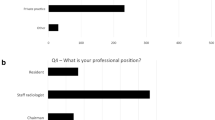Abstract
The incorporation of artificial intelligence into radiological clinical workflow is on the verge of being realized. To ensure that these tools are effective, measures must be taken to educate radiologists on tool performance and failure modes. Additionally, radiology systems should be designed to avoid automation bias and the potential decline in radiologist performance. Designed solutions should cater to every level of expertise so that patient care can be enhanced and risks reduced. Ultimately, the radiology community must provide education so that radiologists can learn about algorithms, their inputs and outputs, and potential ways they may fail. This manuscript will present suggestions on how to train radiologists to use these new digital systems, how to detect AI errors, and how to maintain underlying diagnostic competency when the algorithm fails.


Similar content being viewed by others
References
Doucette JN. View from the cockpit: what the airline industry can teach us about patient safety. Nursing2021 2006;36:50-53
Hudson P. Applying the lessons of high risk industries to health care. BMJ Quality & Safety 2003;12:i7-i12
Gawande A. The checklist. 2007
Clay-Williams R, Colligan L. Back to basics: checklists in aviation and healthcare. BMJ quality & safety 2015;24:428-431
Mongan J, Kohli M. Artificial intelligence and human life: five lessons for radiology from the 737 MAX disasters. Radiology Artificial intelligence 2020;2
Daye D, Wiggins WF, Lungren MP, et al. Implementation of Clinical Artificial Intelligence in Radiology: Who Decides and How? Radiology 2022:212151
Harolds JA, Parikh JR, Bluth EI, et al. Burnout of radiologists: frequency, risk factors, and remedies: a report of the ACR Commission on Human Resources. Journal of the American College of Radiology 2016;13:411-416
Waldman JD, Kelly F, Arora S, et al. The shocking cost of turnover in health care. Health care management review 2010;35:206-211
Food, Administration D. Proposed regulatory framework for modifications to artificial intelligence/machine learning (AI/ML)-based software as a medical device (SaMD). 2019
Li D, Morkos J, Gage D, et al. Artificial Intelligence Educational & Research Initiatives and Leadership Positions in Academic Radiology Departments. Current Problems in Diagnostic Radiology 2022
Perchik J, Smith A, Elkassem A, et al. Artificial Intelligence Literacy: Develo** a Multi-institutional Infrastructure for AI Education. Academic Radiology 2022
Congress U. Airline Safety and Federal Aviation Administration Extension Act of 2010. Public Law 2010:111-215
Longridge T, Burki-Cohen JS, Go TH, et al. Simulator fidelity considerations for training and evaluation of today's airline pilots. 2001
Socha V, Socha L, Szabo S, et al. Training of pilots using flight simulator and its impact on piloting precision. Transport Means Juodkrante: Kansas University of Technology 2016:374-379
Aragon CR, Hearst MA. Improving aviation safety with information visualization: a flight simulation study. Proceedings of the SIGCHI conference on Human factors in computing systems; 2005:441–450
Devices T. European Aviation Safety Agency. 2012
Sullivan NJ, Duval-Arnould J, Twilley M, et al. Simulation exercise to improve retention of cardiopulmonary resuscitation priorities for in-hospital cardiac arrests: a randomized controlled trial. Resuscitation 2015;86:6-13
Towbin AJ, Paterson BE, Chang PJ. Computer-based simulator for radiology: an educational tool. Radiographics 2008;28:309-316
Towbin AJ, Paterson B, Chang PJ. A computer-based radiology simulator as a learning tool to help prepare first-year residents for being on call. Academic radiology 2007;14:1271-1283
Shah C, Davtyan K, Nasrallah I, et al. Artificial Intelligence-Powered Clinical Decision Support and Simulation Platform for Radiology Trainee Education. Journal of Digital Imaging 2022:1–6
Baltzer PA. Automation Bias in Breast AI. Radiological Society of North America; 2023:e230770
Goddard K, Roudsari A, Wyatt JC. Automation bias: a systematic review of frequency, effect mediators, and mitigators. Journal of the American Medical Informatics Association 2012;19:121-127
Do HM, Spear LG, Nikpanah M, et al. Augmented radiologist workflow improves report value and saves time: a potential model for implementation of artificial intelligence. Academic radiology 2020;27:96-105
Fischetti C, Bhatter P, Frisch E, et al. The evolving importance of artificial intelligence and radiology in medical trainee education. Academic Radiology 2022;29:S70-S75
Author information
Authors and Affiliations
Contributions
All authors contributed to the study’s conception and design. The first draft of the manuscript was written by Dr. Umber Shafique, and all authors commented on previous versions of the manuscript. All authors read and approved the final manuscript.”
Corresponding author
Ethics declarations
Ethics Approval
Not applicable.
Consent to Participate
Not applicable.
Consent for Publication
Not applicable.
Competing Interests
The authors declare no competing interests.
Additional information
Take-Home Points
1. Radiologists should be prepared for the implementation of AI into clinical workflow.
2. Training resources should be developed for radiologists at every level of experience.
3. AI software developers, governing bodies, and radiological societies should collaborate to develop solutions to standardize training and minimize the potential of automation bias and skill erosion.
Publisher's Note
Springer Nature remains neutral with regard to jurisdictional claims in published maps and institutional affiliations.
Rights and permissions
Springer Nature or its licensor (e.g. a society or other partner) holds exclusive rights to this article under a publishing agreement with the author(s) or other rightsholder(s); author self-archiving of the accepted manuscript version of this article is solely governed by the terms of such publishing agreement and applicable law.
About this article
Cite this article
Shafique, U., Chaudhry, U.S. & Towbin, A.J. Are the Pilots Onboard? Equip** Radiologists for Clinical Implementation of AI. J Digit Imaging 36, 2329–2334 (2023). https://doi.org/10.1007/s10278-023-00892-z
Received:
Revised:
Accepted:
Published:
Issue Date:
DOI: https://doi.org/10.1007/s10278-023-00892-z



